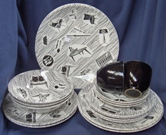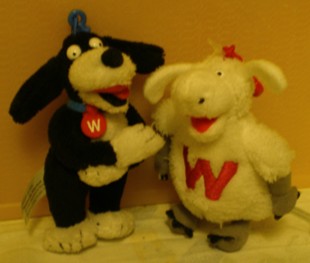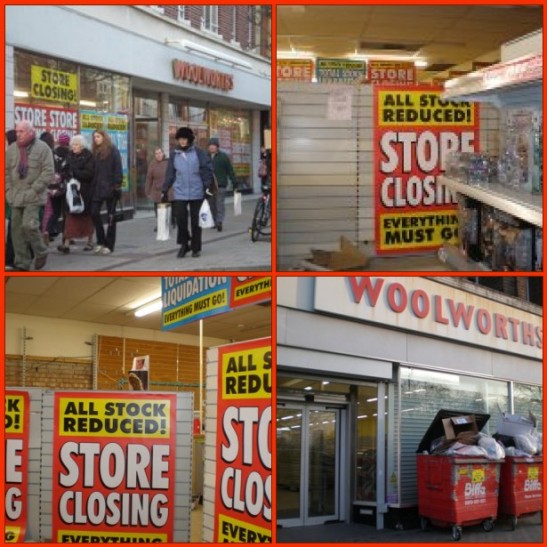by Esmerelda Weatherwax (Jan. 2009)
The demise of the household store FW Woolworth, or Woolies is not a happy event with which to begin 2009 which should have been the shops centenary year.
I know that the firm was originally an American foundation and the unhappy life of Barbara Hutton the “Woolworth’s heiress” as she was called in the press, was well known.
But it became a British institution very quickly in the form the chain of shops took in the UK after the first one opened in 1909 in Church Street Liverpool offering nothing over sixpence. In the 20s and 30s town councils would write to Woolworth HQ in Marylebone begging for a branch to be opened in their town. Recently the letters said things more like “We have not made enough from the car park fees and parking fines that have deterred your customers from coming to the High Street; therefore we are increasing your rent and business rates to the point where even you will find it difficult to operate”. Woolworths owned many of the freeholds of their High Street sites. Then when they became part of the Kingfisher Group those freeholds were sold. So when Woolworths were demerged as an independent entity they had to pay rent on property they have previously owned. This was one of the factors which led to the problems that resulted in the company going into administration.
Very quickly Woolworths became renowned for the variety of goods that could be purchased at an affordable price.
Albert carried his “Stick with the horses head handle, the finest that Woolworths could sell” and everyone knew exactly what Stanley Holloway was trying to describe in the monologue.
During the war my youngest uncle (aged about 9 at the time) was apprehended in Woolworths in Northampton trying to steal an atlas. He didn’t like his evacuation billet and wanted a map for his plan to run away and find his way back to Bethnal Green.
My earliest specific memory of Woolworths is of my father buying me a Airfix model making kits of Joan of Arc and Henry VIII. He later added Richard the Lionheart and Edward the Black Prince which I spent happy hours arranging in mock minibattles. Joan and Richard usually won.
 Woolworths became a solidly working class shop. Unlike the stigma attached to the relatively recent arrivals the “Poundshops” Woolworths was respectable and sold some quality goods. There was a range of crockery called Homemaker, a typical 1950s style of cups saucers and plates decorated with a transfer print of furniture and kitchenware. I didn’t like it then, I still don’t like it now but it has become very collectable for those with the retro taste and pieces in good condition command a good price on e-bay.
Woolworths became a solidly working class shop. Unlike the stigma attached to the relatively recent arrivals the “Poundshops” Woolworths was respectable and sold some quality goods. There was a range of crockery called Homemaker, a typical 1950s style of cups saucers and plates decorated with a transfer print of furniture and kitchenware. I didn’t like it then, I still don’t like it now but it has become very collectable for those with the retro taste and pieces in good condition command a good price on e-bay.
The respectability didn’t quite extend to the younger members of staff. The full time, middle aged matrons, stout ladies in stout blue nylon overalls were unimpeachable. But there was a feeling, unfounded from what I remember of the ones I knew when I worked on Saturdays in the shoe shop next door, that the junior girls, including the Saturday girls, were a good bet for a hot date on a Saturday night. Perhaps it was something to do with the pink nylon overalls. This misapprehension has not continued over into the younger generation and you are as likely to find Saturday boys as girls now. Or were, before the redundancies and closures of last week.
There is a photograph below of everything my husband and I retain that we can remember buying in Woolworths. Toys, fishing tackle, a brooch for my Mum for Mothering Sunday in the early 60s. It says “Mother” just in case it wasn’t bl**ding obvious. Knitting patterns (wool long knitted up and worn out) and dressmaking patterns.
 was This was a very fortunate line. The Simplicity stand was by the front entrance on Lea Bridge Road Leyton, opposite the Bakers Arms pub. My best friend and I could stand there for ages without causing suspicion, ostensibly engrossed in selecting something for the next needlework project but really watching for the boys getting off the buses.
was This was a very fortunate line. The Simplicity stand was by the front entrance on Lea Bridge Road Leyton, opposite the Bakers Arms pub. My best friend and I could stand there for ages without causing suspicion, ostensibly engrossed in selecting something for the next needlework project but really watching for the boys getting off the buses.
In anticipation of a night out with the said boys there was make up. They stocked Rimmel which is still available in Boots and Miners. Their own brand was first Evette which was inexpensive; later they had a better quality range called Tu.
The food hall was well patronised. I do not remember the in house cafes but even into the 1980s when I worked attached to the RCJ the queue would form outside the Holborn branch before opening time at 8.30 for lunches and provisions for the tea clubs. Later in the day people would be shopping for that night’s meal. They carried a good selection of cheese and cold meat. My best friend and her brother were reminiscing on Boxing Day about buying bags of broken biscuits. Then suddenly management made the decision to close the food halls and all that was left was the sweets and chocolate. It was from this point that the famous “pick ‘n’ mix” came into its own.
The fact that many Woolworths stores still have planning permission for retail food is one of the reasons the supermarket chain Iceland is so interested in some sites. I believe that in Australia the Woolworths name is associated purely with food and provision sales. I discovered a very strange Woolworths in Nairobi in the 80s. The story, as I was told it, is that a Kenyan businessman decided to register the Woolworths name in Kenya so that when, as he anticipated, the chain decided to extend operations into east African they would have to pay him a tidy sum for the name. Meanwhile he decided that as he had the name he might as well use it and so he opened this odds and ends general store on the corner of Mama Ngina Street. It did rather well such that he was believed to be of the opinion that should the international chain want a business in Nairobi “his” name would not be for sale. My husband also remembered the shop and the very courteous doorman from a spell in Kenya some years earlier. I believe that there are now several shops with the Woolworths name in Nairobi alone and that they are all now part of Woolworths South Africa, a chain which is at great pains to emphasise that it has no connection whatsoever with the ailing UK company. But the very name retains such prestige.
In recent years Woolworths has aspired to develop as the place to buy music and film. Originally they only sold cover versions of the well known bands. Like Funky Junction’s tribute to Deep Purple. Funky Junction achieved their own success a few years later under their real name of Thin Lizzie and that album (above) is a minor collector’s item. However, whereas later I was able to buy Beatles singles early, and that sale would contribute to that record’s position in next week’s hit parade, and could buy LPs by artists like Joan Baez and Brian Prothero that were never Number One the focus at the end was only on records already in the charts. For anything else people have got into the habit of shopping online at the likes of Amazon. The selection of DVDs was generally quite good and as none of us play games I can’t comment on them.
They also sold guitars under the brand name “Top 20” (and sold very inexpensive acoustic Yamaha’s on line until recently). These were not very good but for some young men they were a beginning for something much, much better. One guitarist I was told of decided that during his next gig he wanted to emulate Pete Townsend by smashing a guitar at the end of the set. His younger brother was persuaded to bring out his redundant Top 20 from the attic and sacrifice it for the greater good of rock and roll. However the guitar was so sturdily made that it refused to smash and dented the stage.
 During the past 20 years the Woolworths adverts, especially the ones at Christmas have been some of the most memorable. From the Advertising manager who fancied himself as a vocalist and knew that his only chance to reach an audience was to sing in his own advert, adverts with very well known celebrities to last year’s daft sheep and dog, Wooly and Worth. This year Wooly and Worth were soft toy keyrings sitting by the till, proceeds to Kids First.
During the past 20 years the Woolworths adverts, especially the ones at Christmas have been some of the most memorable. From the Advertising manager who fancied himself as a vocalist and knew that his only chance to reach an audience was to sing in his own advert, adverts with very well known celebrities to last year’s daft sheep and dog, Wooly and Worth. This year Wooly and Worth were soft toy keyrings sitting by the till, proceeds to Kids First.
Kids First is an independent registered charity whose aim is to enable Woolworth’s employees to support community based projects to benefit local children. It was part of Woolworth’s commitment to be at the heart of the communities it served. As it is independent it may be able to carry on.
This last few weeks watching the shelves empty has been sadder than the demise of any other High Street name. I may have got some bargain printer paper and a half price milk pan but some of my friends are out of a job. And the High Street will be poorer for it.

A selection of pictures taken of several branches in Suffolk, Essex and London over the last two weeks.
.
.
.
To comment on this article, please click here.
Esmerelda Weatherwax is a regular contributor to the Iconoclast our community blog. To view her entries please click here.
To help New English Review continue to publish articles such as this one, please click here.
If you enjoyed this piece and would like to read more by Esmerelda Weatherwax, please click here.
- Like
- Digg
- Del
- Tumblr
- VKontakte
- Buffer
- Love This
- Odnoklassniki
- Meneame
- Blogger
- Amazon
- Yahoo Mail
- Gmail
- AOL
- Newsvine
- HackerNews
- Evernote
- MySpace
- Mail.ru
- Viadeo
- Line
- Comments
- Yummly
- SMS
- Viber
- Telegram
- Subscribe
- Skype
- Facebook Messenger
- Kakao
- LiveJournal
- Yammer
- Edgar
- Fintel
- Mix
- Instapaper
- Copy Link









